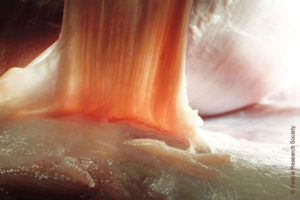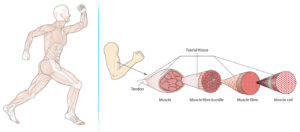What does fascia mean?
Can you train that and why should you? – Yes, one can and yes, one should!
Fascia shapes our outer appearance, determines our health and performance. A well-functioning fascia network increases the quality of life, keeps body and mind healthy, makes us taut and flexible!
Fascia passes through and surrounds our entire body in the form of a fascial network without beginning or end. The components are collagen fibers for strength and stability, elastin fibers for elasticity and flexibility as well as the basic substance as a circulation milieu and transport route. It stabilizes the tissue and protects it from overloading and undesirable effects. At the same time, it allows the fibers to slide, distributes nutrients and breaks down waste products. The fascia as a whole can be seen as a river system. Only if this inner ecosystem is intact and balanced, the basic substance can flow freely and keep the organism in good health. Therefore, a constant “clearing” is necessary in order to be efficient and to optimally implement training effects.

All fascia illustrations for > download
⇒ components of the fascial network:
A few years ago, scientists realized that all fibrous structures are part of the body-wide fascial network that runs through and around our body as a tissue network. It stabilizes, reacts to impulses, is at the same time firm and flexible and is constantly remodeling itself. In some sections, the fascia acts as tendons or ligaments, in others it contains muscle mass, bones or organs or serves as a buffer and storage zone. The fascial network is a living organ with metabolic processes, immune defense, structural cells and receptors.
If one trains fascially, one simultaneously reaches the loose connective tissue, the taut tendons, the flexible muscles and promotes the functioning of the organs. All-in-one!
⇒ characteristics of the fascial network:
Fascia is focused on adapting to the demands that are put on it. Fascial structures are constantly remodelling themselves. There is a constant build-up, dismantling and surrounding, it is continuously interwoven, separated, pulled and pushed. With the fascia, nature has created the preconditions for a body to be able to adapt to almost all conditions.
This knowledge changes the view of the body, of movement and health maintenance in a lasting way and thus also influences training strategies and ways to personal success.
 ⇒ functions of the fascial network:
⇒ functions of the fascial network:
⇒ flexible stability: pulls as an omnipresent tissue network through and around our body: envelops, connects, stabilizes, gives form, keeps us upright by stretching tension and everything in its place; through fascia movement becomes possible in the first instance.
⇒ sixth sense: most comprehensive sensory organ of humans with receptors for our body and movement feeling, emotional expression and sensations.
⇒ protective provider: environment for exchange and transport of nutrients and waste products, cells of the immune system as well as for maintenance, construction, repairs and cleaning by “cell construction workers” and as a barrier for bacteria and viruses.
![]()
Fascia basic substance surrounds and flows through the fascia fiber network
Fascia …
⇒ offers milieu for exchange and transport of nutrients and waste products (all diffusing circulation processes such as metabolism, blood circulation, lymph, ceaccommodates cell construction workers (fibroblasts) for construction, repair and cleaning supply)
⇒ accommodates cell construction workers (fibroblasts) for construction, repair and cleaning
⇒ is location and transport system for free cells (immune system)
⇒ is related to the nervous system and perceives movement information, sensations and pain
![]()

Figure 1: The fascial network surrounds the whole body like a suit with countless pockets. Each pocket merges seamlessly into numerous other pockets. This endless “bag-in-bag” principle makes the fascial network omnipresent in the body. Figure 2: The deeper fascial layer surrounds both the muscle as a whole and each component in detail. All these “sheaths” converge at the end of the muscle and become tendons. © BLV Buchverlag, Fascia training – younger, more beautiful & more flexible


